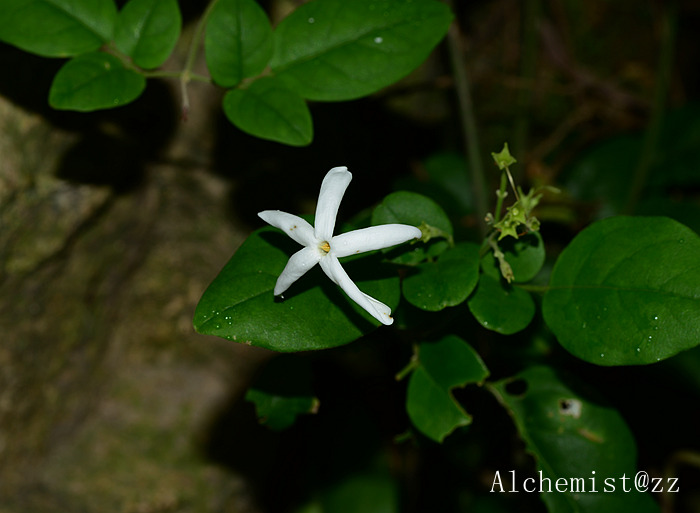- Scientific Name: Jasminum sinense Hemsl.
- Ref: J. Linn. Soc., Bot. 26:80. 1889
- Synonym: Jasminum bodinieri H.Lév.
- Chinese Common Name: 华素馨 Huá sùxīn, 华清香藤 Huá qīngxiāng∙téng
- Japanese Common Name: オキナワソケイ [沖縄素馨] okinawasokei
- Family: Oleaceae
- Genus: Jasminum
- Distribution: Slopes, thickets, woods; below 2000 m. Fujian, Guangdong, Guangxi, Guizhou, Hubei, Hunan, Jiangxi, Sichuan, Taiwan, Yunnan, Zhejiang
- Photo: 09/13/2014, Is. Nanji, Zhejiang
- Note: shares the Japanese common name with J. lanceolaria
Vines twining, 1-8 m. Branchlets terete, densely rusty villous. Leaves opposite, 3-foliolate; petiole 0.5-3.5 cm; leaflet blade ovate to ovate-lanceolate, rarely suborbicular or elliptic, papery, rusty pubescent and more densely so along veins abaxially, base rounded or rounded-cuneate, apex obtuse, acute, to acuminate, primary veins 3-6 on each side of midrib; terminal leaflet 3-12.5 × 2-8 cm, petiolule 0.8-3 cm; lateral leaflets 1.5-6.5 × 0.8-5 cm, petiolule 1-6 mm. Cymes terminal or axillary, many-flowered congested panicles, rarely 1-flowered in leaf axils. Flowers heterostylous. Pedicel 0-5 mm. Calyx pilose; lobes linear, 1-5 mm, slightly enlarged in fruit. Corolla white or yellowish, salverform; tube 1.5-4 cm; lobes 5, oblong or lanceolate, 0.6-1.4 cm. Berry black, globose or subglobose, 0.8-1.7 cm × 6-10 mm. Fl. Jun-Oct, fr. Sep-May. (Flora of China)
